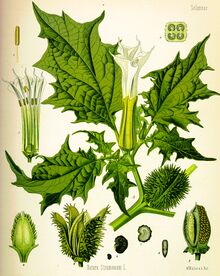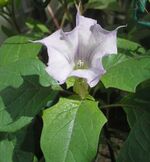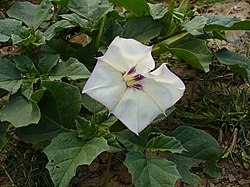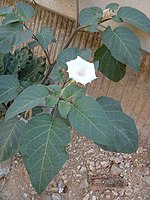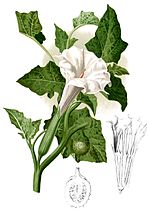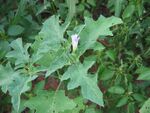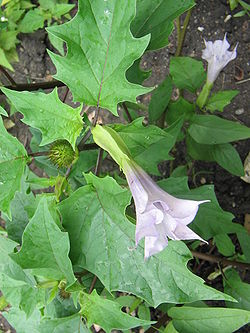Datura

Datura is extremely dangerous and can directly cause severe injury or death.
Datura is highly unpredictable and its use is strongly linked to psychosis, severe injury, and death. Please see this section for more details.
| Summary sheet: Datura |
| Datura | |||||||||||||||||||||||
|---|---|---|---|---|---|---|---|---|---|---|---|---|---|---|---|---|---|---|---|---|---|---|---|
| Chemical Nomenclature | |||||||||||||||||||||||
| Common names | Datura, Jimson Weed | ||||||||||||||||||||||
| Substitutive name | Angel's Trumpets, Devil's Apple, Thorn Apple, Stinkweed, Devil's Weed, Moonflower | ||||||||||||||||||||||
| Class Membership | |||||||||||||||||||||||
| Psychoactive class | Deliriant | ||||||||||||||||||||||
| Chemical class | Tropane alkaloid | ||||||||||||||||||||||
| Routes of Administration | |||||||||||||||||||||||
|
|||||||||||||||||||||||
| Interactions | |||||||||||||||||||||||
Datura (also known as devil's trumpet, moonflower, jimsonweed, devil's weed, hell's bells, thorn-apple, and many others) is a genus of nine species of poisonous flowering plants belonging to the family Solanaceae. Datura is known as powerful and dangerous deliriants, used for shamanic and medical purposes, as well as poisons. They contain the potent anticholinergic substances scopolamine, hyoscyamine, and atropine primarily in their seeds and flowers.[1]
Datura's precise and natural distribution seem to be throughout most of the temperate and tropical regions of the globe, owing to its extensive cultivation and naturalization. The two most well-known species are Datura inoxia and Datura stramonium. Both have been used in a shamanic context for religious purposes on most continents since before recorded history throughout the ancient Americas, Europe, and India.[citation needed]
The potency of Datura is highly variable, as the potency varies depending on mother plants age, the weather it was grown in and the location its growing in. This makes Datura highly dangerous to use as a substance and can lead directly to death, it is highly advised the user does not start with a delirium inducing dosage and uses a scale to measure the dose (though its never safe despite the measuring tools you use.)
Chemistry
The principal psychoactive constituents of all datura plants are the tropane alkaloids scopolamine, hyoscyamine, and atropine. These constituents are structurally analogous compounds.
These tropane alkaloids contain a substituted tropane ring, a seven-membered ring with an N-methylated nitrogen bridge between R1 and R5. Scopolamine additionally has an oxygen bonded to R6 and R7 of this bicyclic structure to form a three membered oxirane ring. They also contain a propionic acid chain, CH3CH2COOH, which is substituted at R2 with an aromatic phenyl ring and at R3 with a hydroxyl group OH-. The propionic acid chain is linked at R1 through an oxygen atom to R3 of the substituted tropane ring to form an ether.
These compounds are secondary metabolites synthesized naturally by various plants. The ratio of these compounds in datura plants varies greatly depending on location, growing conditions, etc. The datura genus contains other chemical constituents, but limited research has been done on their properties. Scopolamine, hyoscyamine, and atropine have a stereocenter at R2 of their propionic chain. Hyoscyamine is the levorotorary enantiomer of atropine.
Pharmacology
The alkaloids within datura exert their effects by acting as competitive antagonists at muscarinic acetylcholine receptors, primarily muscarinic acetylcholine receptors M1 and M2. Although the precise mechanism is not understood, it’s this inhibition of acetylcholine which leads to delirium, sedation and intensely realistic hallucinations alongside of extremely uncomfortable and dysphoric physical side effects.
All parts of Datura plants contain dangerous levels of the tropane alkaloids atropine, hyoscyamine, and scopolamine, which are classified as deliriants, or anticholinergics. The risk of fatal overdose is high among uninformed users, and many hospitalizations occur among recreational users who ingest the plant for its psychoactive effects. Deliberate or inadvertent poisoning resulting from smoking jimsonweed and other related species has been reported.
Cultivation
Datura stramonium prefers rich, calcareous soil. Adding nitrogen fertilizer to the soil increases the concentration of alkaloids present in the plant. D. stramonium can be grown from seed, which is sown with several feet between plants. It is sensitive to frost, so should be sheltered during cold weather. The plant is harvested when the fruits are ripe, but still green. To harvest, the entire plant is cut down, the leaves are stripped from the plant, and everything is left to dry. When the fruits begin to burst open, the seeds are harvested.
Subjective effects
Disclaimer: The effects listed below cite the Subjective Effect Index (SEI), an open research literature based on anecdotal user reports and the personal analyses of PsychonautWiki contributors. As a result, they should be viewed with a healthy degree of skepticism.
It is also worth noting that these effects will not necessarily occur in a predictable or reliable manner, although higher doses are more liable to induce the full spectrum of effects. Likewise, adverse effects become increasingly likely with higher doses and may include addiction, severe injury, or death ☠.
Physical effects 
-
The physical effects of datura can be described as extremely unpleasant and distressing to the extent that they make enjoying the experience impossible especially at common to heavy dosages.
- Sedation or Stimulation
- Perception of bodily heaviness - The first noticeable sensation is having an extremely heavy body as if the gravity one is subject to has increased exponentially. This makes it extremely difficult and uncomfortable to move.
- Spontaneous bodily sensations - Users commonly report all-encompassing, sharp and extremely painful jolts of electricity that spontaneously manifest themselves in a similar rhythm to hiccups.
- Abnormal heartbeat[citation needed]
- Bronchodilation
- Constipation
- Dehydration
- Respiratory depression[citation needed]
- Dizziness
- Gustatory hallucination
- High blood pressure[citation needed]
- Increased bodily temperature[citation needed]
- Increased heart rate[citation needed]
- Increased perspiration
- Motor control loss
- Muscle cramps
- Muscle spasms
- Nausea or Nausea suppression - Datura can be used to treat nausea at low doses. At high, delirium-inducing doses, it can cause significant amounts of nausea, although it rarely leads to vomiting. In some rare cases bile reflux is possible.
- Olfactory hallucination
- Physical fatigue
- Restless leg syndrome
- Seizures[citation needed]
- Tactile enhancement
- Tactile hallucination
- Tactile suppression
- Temporary erectile dysfunction
- Difficulty urinating and Frequent urination- This can be described as a feeling of concrete blocking the urethra, painfully conflicting with a frequent need to urinate.
- Photosensitivity
- Pupil dilation - Datura blocks receptors in the muscles of the eye that constrict pupil size.[citation needed] This can result in an extreme sensitivity to light which can last for weeks after the experience in certain cases, also it blocks the accommodation reflex causing vision to be unfocused.[citation needed] Prolonged usage is reputed to cause blindness.[2]
Visual effects 
-
Datura does not enhance the processing of visual stimuli in the same way psychedelics do. Instead, it tends to degrade and decrease visual aptitude while increasing hallucinations and perceptual delusions.
Suppression
- Visual acuity suppression - This effect can blur your vision to the point where it can be impossible to read and can last for days after the experience. [3]
- Double vision
- Pattern recognition suppression
- Vibrating vision
Distortions
- Drifting (melting, breathing, morphing and flowing) - In comparison to other hallucinogens, this effect can be described as intricate in complexity; jittery, slow and rigid in motion; static in permanence; realistic in believability and interactive in plasticity
- After images
- Visual haze
- Object alteration
Hallucinatory states
Datura is extremely efficient at inducing delirious hallucinations which can be broken into the categories described below:
- External hallucination (autonomous entities; settings, sceneries, and landscapes; perspective hallucinations and scenarios and plots) - In comparison to other classes of hallucinogen, this effect occurs more frequently than that of any other at moderate to heavy doses and is the defining feature of the experience. It can be comprehensively described through its variations as delirious in believability, autonomous in controllability and solid in style. The most common themes for these hallucinations include those of everyday occurrences such as smoking phantom cigarettes, talking to people who are not there, insects and sinister, nightmarish experiences.
- Internal hallucination (autonomous entities; settings, sceneries, and landscapes; perspective hallucinations and scenarios and plots) - In comparison to other classes of hallucinogen, this effect occurs briefly and spontaneously at moderate doses but becomes progressively extended in its occurrence and duration proportional to dosage before eventually becoming all-encompassing. It can be comprehensively described through its variations as delirious in believability, interactive in style, equal in new experiences and memory replays in content, autonomous in controllability and solid in style.
- Peripheral information misinterpretation
- Shadow people
- Unspeakable horrors
- Object activation
Cognitive effects 
-
The cognitive effects of datura are described by many as generally negative and dysphoric, often consisting of extreme paranoia and feelings of impending doom. Like other deliriants, datura is confusing and disorienting, often leading to a complete inability to communicate or understand normal language.
- Sleepiness - In terms of its effects on the user's physical energy levels, datura is commonly considered to be extremely tiring.
- Wakefulness - Even though datura is a depressant overall and causes sleepiness, it has stimulant effects on the body, which can also keep the user awake. This effect predominates sleepiness at higher dosages.
- Motivation suppression - Datura can cause complete loss of motivation to do anything. This is often accompanied by depression and can make the user extremely bored.
- Increased libido - Datura stramonium seeds have been known to increase libido and sex drive for a number of its users. Throughout history and still today dried datura seeds have even been boiled or made into ointments with various other ingredients added and occasionally other psychoactive substances which were often applied to the genitals for treating sexual impotency. This however is not recommended due to the plant's unpredictable levels of toxicity.
- Amnesia - In some cases this has been known to lead to anterograde amnesia which is a persisting negative effect on the user's memory capacity that occurs even after the experience has ended. This effect causes one to have difficulty forming new memories directly after and as a result of an amnesic episode.
- Anxiety
- Cognitive dysphoria - The levels of dysphoria experienced, however, vary between people with a very small percentage of users reporting that they do not seem to experience them at all.
- Cognitive fatigue
- Confusion
- Delirium
- Delusion
- Depersonalization
- Depression
- Derealization
- Dream potentiation
- Emotion suppression
- Feelings of impending doom
- Focus suppression
- Information processing suppression
- Language suppression
- Memory suppression
- Paranoia
- Psychosis
- Suggestibility enhancement
- Time distortion
- Thought deceleration
- Thought disorganization
Auditory effects 
After effects 
-
Due to its stimulant and deliriant effects, datura can cause mild to significant after effects when "coming down". These effects commonly include:
- Anxiety
- Brightness alteration - This can often manifest itself in the form of photophobia.
- Cognitive fatigue
- Dehydration
- Delirium - This possible after effect is not as consistent or as long lasting usually but can be more likely to present itself if taken consecutively or in high dosages. In rare circumstances or when taken too frequently, this can display itself in the form of temporary or even long-term psychosis and a general disconnection from reality.
- Depression
- Language suppression
- Motivation suppression
- Peripheral information misinterpretation
- Pupil dilation - This often tends towards the individual experiencing diffraction even long after the initial intoxication has worn off.
- Sleepiness
- Thought deceleration
- Visual acuity suppression - This often consists of a feeling of being temporarily farsighted and often renders one unable to read due to heavily blurred vision.
Experience reports
Anecdotal reports which describe the effects of this compound within our experience index include:
- Experience: 450 Datura seeds - Talking to Ghosts
- Experience:Datura & DPH - Results of Experiment by Isopropanol
- Experience:Datura Alcoholic Tincture
- Experience:Datura and nicotine smoked - 4 and ~15 hits; was actually quite pleasant
Additional experience reports can be found here:
Natural plant sources
Due to its extensive cultivation and naturalization throughout the temperate and tropical regions, datura is found in most areas of the world. There are nine identified species:
Toxicity and harm potential
 |
This toxicity and harm potential section is a stub. As a result, it may contain incomplete or even dangerously wrong information! You can help by expanding upon or correcting it. |
Datura is known to be extremely unpredictable and has the potential to result in severe consequences, hospitalization or death. The toxicity and long-term health effects of regular datura usage do not seem to have been studied in any scientific context and the exact toxic dosage is unknown. This is because long-term datura usage is very rare and the vast majority of people who try it do not desire to repeat the experience.
In traditional cultures, a great deal of experience with and detailed knowledge of datura was critical to minimize harm.[4][5] Many fatal incidents result from modern users ingesting datura. For example, in the 1990s and 2000s, the United States media contained stories of adolescents and young adults dying or becoming seriously ill from intentionally ingesting datura.[6][7] There are also several reports in the medical literature of deaths from D. stramonium and D. ferox intoxication.[8][9][10] Children are especially vulnerable to atropine poisoning and their prognosis is likely to be fatal.[11][12]
In some parts of Europe and India, datura has been a popular poison for suicide and murder. From 1950 to 1965, the State Chemical Laboratories in Agra, India investigated 2,778 deaths caused by ingesting datura.[4][5][13]
Psychosis
Datura has been reported to cause psychosis and delirium at a significantly higher rate than other hallucinogens like LSD, ketamine, or DMT. There are a large number of experience reports online which describe states of psychotic delirium, amnesia, and other serious consequences after abusing the drug. In many cases, it has resulted in hospitalization and death.
Lethal dosage
There can be a 5:1 potency variation between plants and a given plant's toxicity depends on its age, where it is growing, and the local weather conditions. This variation makes datura exceptionally hazardous as a drug and there is no way for the common man to accurately measure the dosage of any given plant. Datura has been used for centuries in some cultures as a poison because of the presence of these substances.[4][5]
The safest way to prevent overdose is to grind the dried plant matter into an extremely fine and even powder so that the active chemicals within them are distributed evenly across itself. From here, one can slowly work their way up in extremely small increments until the correct dose for that particular plant is found.
It is strongly advised that one avoid using datura altogether. Otherwise, extreme caution and harm reduction practices should be used, such as having a sober and prepared trip sitter present throughout the experience.
Tolerance and addiction potential
The use of datura can be considered mildly addictive with a high potential for adverse side effects such as psychosis. Datura is reported to be significantly less addictive than than other substances because the vast majority of people who try it do not wish to repeat the experience.
Tolerance to many of the effects of datura develops with repeated use. This results in users having to administer increasingly large doses to achieve the same effects. After that, it takes about 3 - 7 days for the tolerance to be reduced to half and 1 - 2 weeks to be back at baseline (in the absence of further consumption). Datura presents cross-tolerance with deliriants, meaning that after the consumption of datura, all deliriants will have a reduced effect.
Legal status
 |
This legality section is a stub. As such, it may contain incomplete or wrong information. You can help by expanding it. |
Datura grows naturally and is legal to grow, sell and consume in most parts of the world. It is, however, restricted within the following countries:
- Australia: Datura is a Schedule I poison in Australia[citation needed], but scopolamine is Schedule 4 (Prescription only) and a scopolamine analogue (hyoscine butylbromide) is available in over the counter drugs (e.g. Buscopan & others) to treat symptoms such as nausea, stomach pain and cramps. Datura and Brugsmansia are legal to process, but are illegal to cultivate without a license.[citation needed]
- Brazil: Datura (suaveolens Willd.) is illegal to grow, handle, possess, store, transport, import, export, prescribe, administer, sell and advertise.[14]
- United Kingdom: Datura is illegal to produce, supply, or import under the Psychoactive Substance Act, which came into effect on May 26th, 2016.[15]
- United States: Datura is legal to produce, supply and import.
- California: Except for legitimate medical purposes, a person may not possess or use the plant known as Datura stramonium
See also
External links
- Datura (Wikipedia)
- Datura (Erowid)
- Scopolamine (DrugBank)
- Atropine (DrugBank)
- Hyoscyamine (DrugBank)
- Datura (Drugs-Wiki)
Discussion
References
- ↑ Freye, E. (2010). "Pharmacology and Abuse of Cocaine, Amphetamines, Ecstasy and Related Designer Drugs: A comprehensive review on their mode of action, treatment of abuse and intoxication". In Freye, E. Toxicity of Datura Stramonium. Springer Netherlands. pp. 217–218. doi:10.1007/978-90-481-2448-0_34. ISBN 9789048124480.
- ↑ Wood, G. B. (1856). A Treatise on Therapeutics, and Pharmacology: Or Materia Medica. Lippincott.
- ↑ Datura - Erowid Exp - “Out of Body Delusional Poison”
- ↑ 4.0 4.1 4.2 Preissel, U., Preissel, H.-G. (2005). Brugmansia and Datura: angel’s trumpets and thorn apples. Firefly ; Chris Lloyd [distributor. ISBN 9781552095980.
- ↑ 5.0 5.1 5.2 Adams, J. D., Garcia, C. (December 2005). "Spirit, Mind and Body in Chumash Healing". Evidence-based Complementary and Alternative Medicine. 2 (4): 459–463. doi:10.1093/ecam/neh130. ISSN 1741-427X.
- ↑ Suspected Moonflower Intoxication --- Ohio, 2002
- ↑ Jimson weed users chase high all the way to hospital - USATODAY.com
- ↑ Michalodimitrakis, M., Koutselinis, A. (October 1984). "Discussion of "Datura stramonium: a fatal poisoning"". Journal of Forensic Sciences. 29 (4): 961–962. ISSN 0022-1198.
- ↑ Boumba, V. A., Mitselou, A., Vougiouklakis, T. (April 2004). "Fatal poisoning from ingestion of Datura stramonium seeds". Veterinary and Human Toxicology. 46 (2): 81–82. ISSN 0145-6296.
- ↑ Steenkamp, P. A., Harding, N. M., Heerden, F. R. van, Wyk, B.-E. van (October 2004). "Fatal Datura poisoning: identification of atropine and scopolamine by high performance liquid chromatography/photodiode array/mass spectrometry". Forensic Science International. 145 (1): 31–39. doi:10.1016/j.forsciint.2004.03.011. ISSN 0379-0738.
- ↑ Taha, S. A., Mahdi, A. H. (1984). "Datura intoxication in Riyadh". Transactions of the Royal Society of Tropical Medicine and Hygiene. 78 (1): 134–135. doi:10.1016/0035-9203(84)90196-2. ISSN 0035-9203.
- ↑ Djibo, A., Bouzou, S. B. (November 2000). "[Acute intoxication with "sobi-lobi" (Datura). Four cases in Niger]". Bulletin De La Societe De Pathologie Exotique (1990). 93 (4): 294–297. ISSN 0037-9085.
- ↑ Andrews, D., Daturas
- ↑ Article (artigo) 33, Lei nº 11.343 of 23/8/2006, referring to chart E (lista E) of the Portaria SVS/MS nº 344 of 12/5/1998, last amended by Resolução de Diretoria Colegiada - RDC nº 835 of 13/12/2023, as of 29/2/2024.
- ↑ Psychoactive Substances Act 2016
